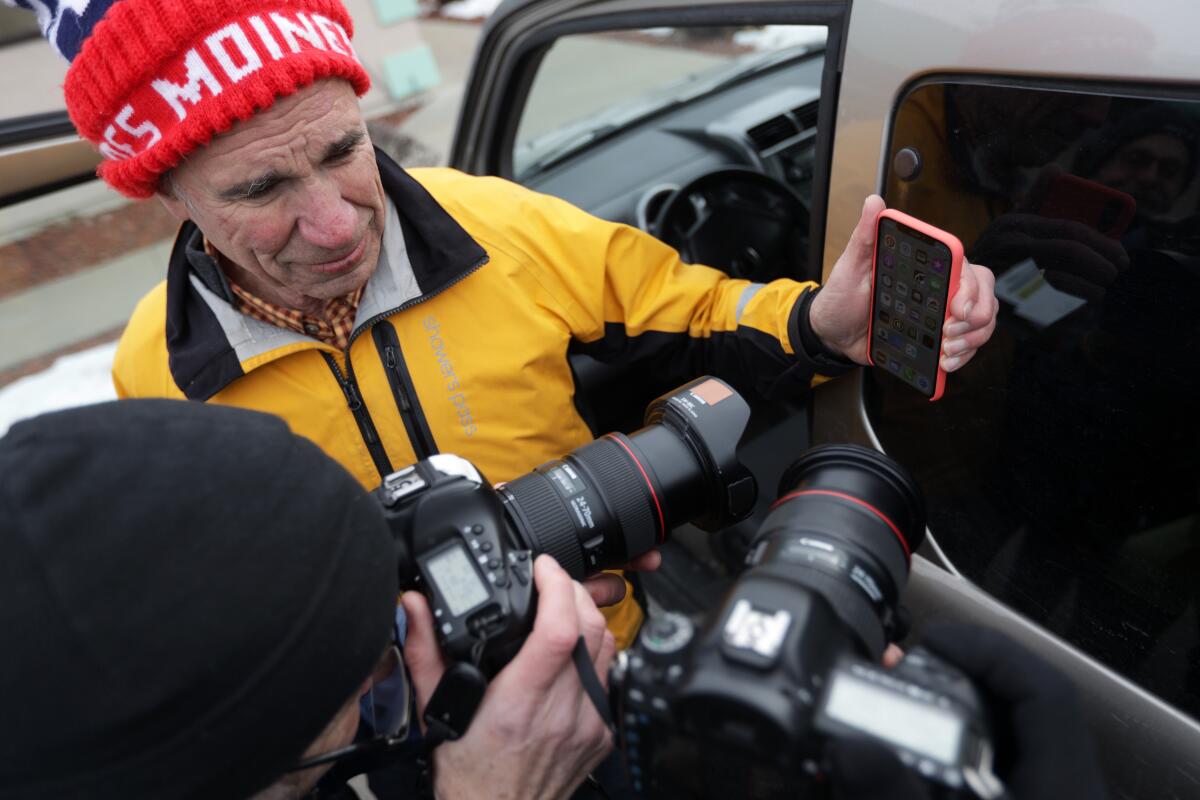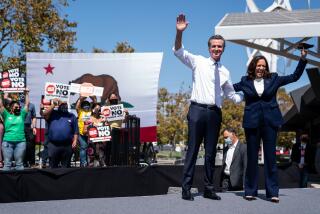Iowa caucuses disaster is a cautionary tale for the California primary

- Share via
After years of national heckling for holding elections that last longer than the time it takes to binge-watch several seasons of a TV show, it’s no wonder that California political insiders are breathing of sigh of relief: At least we’re not Iowa.
“I worry about the [executive director] of the Iowa Democratic Party, who must be curled up in a fetal position on a ratty couch in headquarters,” Cynthia Bryant, executive director of the California Republican Party, wrote in a tweet on Tuesday. “Then I just laugh and am glad for our crazy California system, an election that lasts for 60 days.”
On paper, there are few — if any — similarities between the boisterous, political party-controlled Iowa caucuses and California’s statewide primary, which is conducted by local elections officials and will be held on March 3. Voting rights advocates will point out that they are political apples and oranges: Iowa’s caucusgoers choose sides in public, and California voters use a traditional secret ballot — increasingly cast by mail rather than in person. And while Iowa’s Democrats placed their bets on a new app-based tallying system, Californians are favoring an election experience that’s been around since the Civil War: the absentee ballot.
And yet, it’s hard to ignore the cautionary tale that Iowa’s fiasco provides for California, where a pair of significant changes to the voting process will be implemented in next month’s statewide primary. Added to the state’s long list of other unique voting laws, the changes will test the capacity of elections officials and the knowledge of the state’s 20 million voters. And it will all play out in the middle of one of the most closely watched and contentious presidential campaigns in American history.
California prides itself on having some of the most pro-voter laws in the nation, all largely designed to maximize the opportunities for eligible citizens to cast a ballot and have it counted. It’s been almost two decades since California established “no-fault” absentee voting — voters no longer need to provide a reason to vote by mail, such as a physical limitation or an out-of-state trip.
In 2012, election officials created an online voter registration system. Four years later, state lawmakers put in place an automatic voter registration process at the Department of Motor Vehicles. Subsequent laws have extended the amount of time for ballots to arrive after election day and have required officials to notify voters who forget to sign a ballot envelope before dropping it in the mail.
These and other state laws have helped create what’s effectively become a month-long election. Ballots begin arriving in mailboxes across California before the Iowa caucuses or early primary states have served their time-honored tradition of culling the presidential herd. And it now routinely takes elections officials most, or all, of the 30-day window provided in state law to fully count all ballots.
But two other new laws will have a significant impact on the California primary that will reach its crescendo on the first Tuesday in March, when voters will cast ballots to award 494 delegates to the Democratic National Convention and 172 delegates to the Republican National Convention — many more than those decided in Iowa.
The most far-reaching change to the process is that Californians can now register to vote on election day at locations in all of the state’s 58 counties. So-called “same-day” registration provides more flexibility to those who make a last-minute decision to participate in the election. It also gives registered voters the chance to change their party affiliation and cast a ballot in presidential contests that are closed to nonparty voters.
Substantial infrastructure is needed to register voters at all of those sites. It’s also untested on a statewide level, and is likely to mean that tens of thousands of votes won’t be counted until each person’s registration is confirmed after election day.
Layered on top of that is the expansion of a 2016 state law that swaps the traditional neighborhood polling place for a multi-purpose “vote center.” These locations are open for several days — some as many as 10 — before the election. Voters can visit any site they want, not just one near where they live. And in most counties that have opted in to the new law, a voter’s ballot can be reprinted if needed and additional help is offered for those who don’t speak English.
Five California counties adopted the new voting process in 2018 and 10 more have done so this year. None, though, will be as closely watched as Los Angeles County, home to almost 5.5 million voters.
L.A. voters will not be automatically mailed a ballot, even though their traditional polling places will have disappeared. Those who don’t request an absentee ballot by the state’s Feb. 25 deadline will need to visit one of the county’s 965 vote centers. And if county leaders are to avoid angry tales of Angelenos stuck in traffic as they scramble to find a voting center on election day, the public awareness campaign now underway will have to cleanly hit its mark.
For many people the act of voting is a sense memory, something they are certain they know how to do — until, of course, they don’t. Changes to the process often can improve participation levels and remove confusion. But it’s a lot more complicated than selecting candidates, and elections officials are often leery of sweeping changes that happen all at once.
California lawmakers and activists want to make national headlines on Mar. 3, but for the right reasons.
More to Read
Sign up for Essential California
The most important California stories and recommendations in your inbox every morning.
You may occasionally receive promotional content from the Los Angeles Times.














